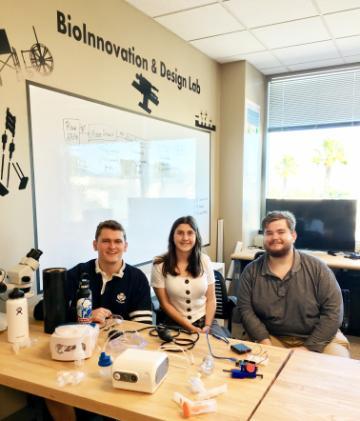Destigmatizing Asthma

In the United States, more than 6 million children under the age of 18 have been diagnosed with asthma, according to the Centers for Disease Control, and that number has been increasing since the 1980s. Treatment for the disease often includes regular use of a nebulizer—a device that changes liquid medication into a fine mist that is more easily delivered to the lungs. The problem with this therapy is that nebulizers are loud, big, bulky, and require sessions of up to 20 minutes just sitting in one place, breathing the medication in through a mask. Kids don’t like to sit still for that long, and teens don’t like to feel different from their peers, so compliance becomes an issue.
Looking for a solution to this problem, Dr. Niki (Amita) Saxena, a local pediatrician, reached out to Prashanth Asuri, director of SCU’s BioInnovation and Design Lab and associate professor of bioengineering. A patient’s parent had suggested a nebulizer disguised as an e-cigarette lookalike might take some of the embarrassment out of treatment. Of course, a pediatrician is never going to advocate smoking of any kind, especially for kids with asthma, but the idea of a hidden nebulizer intrigued Murray Bartho, Michael Breshock, and Megan Nolte, who were looking for a challenge. The team set out to create a prototype of some kind of undercover nebulizer as their senior design project.
They started off by getting a handle on the market. Over the summer, Asuri assigned the team readings on needs finding. “The readings were not intended to be a means to finding a solution, but rather to help define the different types of customers, understand customer needs, and convert this information into product requirements,” he said. To further define the direction of their project, the team created a survey which Dr. Saxena sent to her patients. To reach a larger audience, they also posted a survey on Facebook and LinkedIn.
Survey results confirmed their suspicions that portability and ease of use were important design constraints. More research was conducted on how they might shrink current components to suit their needs. A jet nebulizer, the most common and cheapest to produce, would be difficult to make small enough to be portable. Ultrasonic mesh nebulizers are efficient and portable, but expensive. The team wanted to prototype a device sized and priced to compete with what is currently on the market. They decided to make a nebulizer that people could take camping, or use in the car, or have in their backpack. But what should it look like? It had to appear as something so ubiquitous it would go unnoticed.
“We asked ourselves, ‘what’s something people have with them all the time, that’s easy to carry, and not noticed at all?’” said Megan. It hit them—they could hide their device inside a water bottle or Hydro Flask! “The mouthpiece is already there, it has portability, people can use it wherever they are,” Murray said. “They can carry it on their backpack; there’s already a holder there, so it fits into the existing infrastructure.”
Their bioengineering background was strong. Among the three of them they have all the major’s tracks covered: biomolecular/biotech, pre-med, and medical devices. So the team was well equipped to design the prototype. But with limited mechatronic experience, building the actual device was a stretch, so they enlisted the help of sophomore mechanical engineering students. Asuri notes that the projects hosted by the BioInnovation and Design Lab are interdisciplinary in nature, both by design, but also due to the complex nature of the projects offered by its industry partners. “One cannot imagine running a project like this without first establishing collaborative, interdisciplinary teams,” he said. Another tenet of the Lab is achieving vertical integration on projects. Asuri explained: “An open-ended project like this is appropriate for seniors, but might be too much for sophomores and juniors to take on. Having them work on small pieces of the project gives exposure to real-world customer experiences and is suitable for their level of education. Scaffolding bits of the work also mimics how teams work in the industry, and in this case, [it] enabled the seniors to implement a pump into their design,” he explained.
Megan, Murray, and Michael have found working with a real customer for their senior design project very rewarding. “We’re not imagining what might be useful,” Michael said. “We’re addressing specific needs and putting things together to address a real problem. When we talk with people about the project, they get excited. That confirms to us this type of product is useful and needed.”